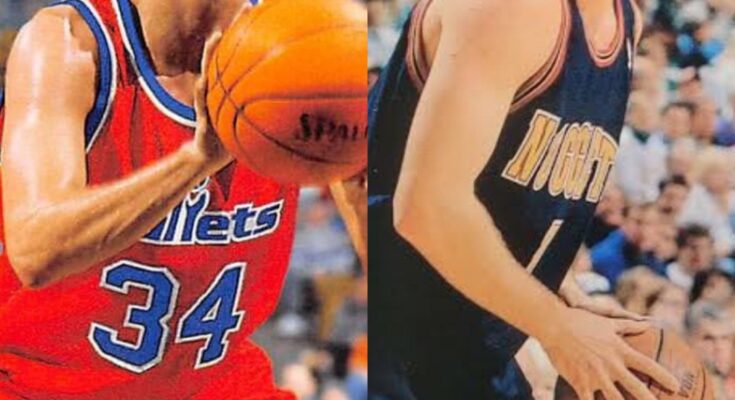The NBA Oddity: How Don MacLean Was Traded for Himself in a Rare Basketball Transaction Cycle
In the vast, colorful history of the NBA, trades are a regular occurrence—players moving from one team to another, reshaping rosters, strategies, and sometimes the fate of franchises. But among all the trades, some stand out for their sheer oddity or uniqueness. One such intriguing episode involves journeyman Don MacLean, who, during the 1992 NBA season, became part of an unusual transaction cycle that effectively had him traded for himself. This curious sequence of events is a fascinating slice of basketball trivia that reveals just how quirky the business side of professional sports can be.
To understand how this happened, it’s important to first appreciate the context of the NBA in the early 1990s. The league was in a period of transition—players moved frequently, and the Bullets (now the Wizards) and Nuggets were teams often involved in dynamic roster changes. Don MacLean was a solid, if not superstar, player—a dependable forward known for his scoring ability in college and his perseverance in the league. His career was marked by multiple trades and movements, typical for role players who could fill gaps for various teams.
The story begins in 1992 when the Washington Bullets traded Don MacLean to the Denver Nuggets. This was a straightforward trade in principle, part of the usual roster reshuffling teams undertake to address immediate needs or future planning. What makes this transaction memorable, however, is what followed later that same season. The Nuggets, for reasons tied to their own team strategy or unforeseen circumstances, decided to trade MacLean back to the Bullets. This secondary trade created a rare cycle—Don MacLean was sent away from Washington only to return in a separate deal.
While trades happen frequently, the fact that MacLean was involved in both sides of these deals in the same season is a peculiar and almost paradoxical situation. From a technical standpoint, MacLean became part of a transaction loop where he was essentially traded for himself. He left the Bullets and then came back to the same team, making his trade journey resemble a full circle. This loop is not only uncommon but also highlights how the transactional nature of professional sports sometimes leads to bizarre outcomes.
One might wonder why a team would trade a player away only to bring him back within months. Several factors could have played into this. Teams may trade players to acquire assets, like draft picks or other players, and later find value in re-acquiring a familiar face. Sometimes, player performance, injuries, or changes in coaching strategies can shift a team’s priorities mid-season, prompting a reversal or a new trade involving the same personnel.
In MacLean’s case, it was likely a combination of such strategic moves and circumstances that resulted in him returning to Washington. The timing of the trades was crucial—it wasn’t just a single deal involving a complicated three-way trade or conditional picks but rather two separate transactions that, when viewed together, formed a cycle. This makes the trade notably unusual, earning it a spot in the annals of NBA quirks.
For Don MacLean, being traded for himself might have been just another chapter in his journeyman career, but for NBA historians and fans of unusual sports facts, it’s a captivating story. It exemplifies how sports management, with all its complexities and calculated risks, sometimes produces unexpected scenarios that can baffle even the most seasoned analysts.
This particular trade cycle involving MacLean reminds us that behind the thrilling dunks, buzzer-beaters, and championship runs, there’s a layer of strategy and business maneuvers that can be just as intriguing. Trades are often about numbers, contracts, and future planning, but they also involve human stories—players uprooted from their teams, cities, and fanbases, only to return unexpectedly. The emotional and psychological impact on players in such situations is seldom discussed, but it adds another dimension to understanding professional sports.
Looking back at the 1992 NBA season and Don MacLean’s peculiar journey, it serves as a testament to the unpredictable nature of basketball trades. It also highlights how even seemingly routine player transactions can turn into legendary tales that captivate fans and become part of the league’s rich tapestry of stories.
Today, whenever basketball fans encounter a strange trade or an odd player movement, the story of Don MacLean being traded for himself serves as a benchmark for one of the most unusual trade cycles in NBA history. It’s a reminder that the business of basketball can sometimes blur the lines between strategy and serendipity, making the sport endlessly fascinating beyond the hardwood floor.
In the grand scheme of the NBA, Don MacLean’s unique trade cycle might be a footnote, but it is one of those rare moments that showcases the unexpected quirks lurking behind the scenes. For players, teams, and fans alike, it’s a story worth remembering — a curious piece of basketball lore where a player, quite literally, was traded for himself.



